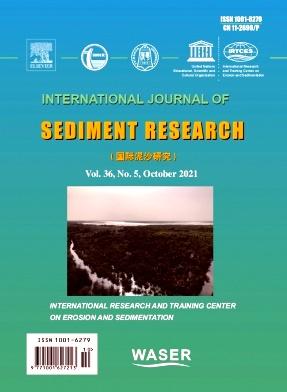The use of InVEST-SDR model to evaluate soil erosion and sedimentation in the closer catchment of a proposed tropical reservoir in Sri Lanka
IF 3.7
2区 环境科学与生态学
Q2 ENVIRONMENTAL SCIENCES
引用次数: 0
Abstract
Soil erosion is a significant environmental threat, impacting water quality and the siltation of the productive capacity of reservoirs. To prioritize soil conservation areas for sustainable land management, quantitative spatial assessment of soil erosion is essential, particularly in the catchment of a reservoir. The current study aims to evaluate the soil erosion severity and sediment generation in the closer catchment of a proposed reservoir, the lower Malwathu Oya Reservoir in Sri Lanka. Erosion modeling has proven cost-effective in assessing the spatial distribution of soil erosion severity. This current study utilized the Integrated valuation of ecosystem services and tradeoffs sediment delivery ratio (InVEST-SDR) model to analyze the spatial distribution of soil erosion and sediment export. A digital elevation model (30 m × 30 m), 22 years of rainfall data, land use and land cover data, soil map, and cropping factors were used as model inputs. The results revealed an average annual soil loss ranging from 0 to 15.55 t/(ha·y) in the catchment and a mean annual sediment export of 0.016 t/(ha·y). Erosion severity was classified into four hazard classes, i.e., insignificant (<0.5 t/(ha·y)), weak (0.5–3 t/(ha·y)), considerable (3–12 t/(ha·y)), and severe (12 < t/(ha·y)). A critical 0.12% area was identified as a considerable soil erosion hazard area, necessitating urgent measures for erosion control. High-risk areas were at Galpottegama, Asirikgama, Puleliya, Navodagama, and Thuppitiyawa Grama Niladari. These findings provide valuable insight for formulating and implementing soil conservation practices in the catchment to reduce the siltation of the proposed lower Malwathu Oya reservoir. The study is an example of using InVEST-SDR to evaluate the sedimentation of a proposed reservoir.

利用InVEST-SDR模型评估斯里兰卡拟建的热带水库附近集水区的土壤侵蚀和沉积
水土流失是一个重大的环境威胁,影响着水库的水质和生产能力。为了优先考虑可持续土地管理的土壤保持区,必须对土壤侵蚀进行定量空间评估,特别是在水库集水区。目前的研究旨在评估一个拟议的水库——斯里兰卡Malwathu Oya水库——的近集水区的土壤侵蚀严重程度和沉积物生成。侵蚀模型在评估土壤侵蚀严重程度的空间分布方面已被证明是具有成本效益的。本研究利用生态系统服务与输沙权衡综合评价(InVEST-SDR)模型分析了土壤侵蚀与输沙的空间分布。采用数字高程模型(30 m × 30 m)、22年的降雨数据、土地利用和土地覆盖数据、土壤图和种植因子作为模型输入。结果表明,流域年平均土壤流失量为0 ~ 15.55 t/(ha·y),年平均输沙量为0.016 t/(ha·y)。侵蚀严重程度分为不显著(0.5 t/(ha·y))、弱(0.5 - 3 t/(ha·y))、相当(3-12 t/(ha·y))和严重(12 <;t /(哈·y))。有0.12%的临界区域被确定为相当大的水土流失危险区,需要采取紧急的水土流失治理措施。高风险地区为Galpottegama、Asirikgama、Puleliya、Navodagama和Thuppitiyawa Grama Niladari。这些发现为制定和实施流域土壤保持措施提供了有价值的见解,以减少拟议的Malwathu Oya下游水库的淤积。该研究是使用InVEST-SDR评价拟建储层沉积的一个例子。
本文章由计算机程序翻译,如有差异,请以英文原文为准。
求助全文
约1分钟内获得全文
求助全文
来源期刊
CiteScore
6.90
自引率
5.60%
发文量
88
审稿时长
74 days
期刊介绍:
International Journal of Sediment Research, the Official Journal of The International Research and Training Center on Erosion and Sedimentation and The World Association for Sedimentation and Erosion Research, publishes scientific and technical papers on all aspects of erosion and sedimentation interpreted in its widest sense.
The subject matter is to include not only the mechanics of sediment transport and fluvial processes, but also what is related to geography, geomorphology, soil erosion, watershed management, sedimentology, environmental and ecological impacts of sedimentation, social and economical effects of sedimentation and its assessment, etc. Special attention is paid to engineering problems related to sedimentation and erosion.

 求助内容:
求助内容: 应助结果提醒方式:
应助结果提醒方式:


